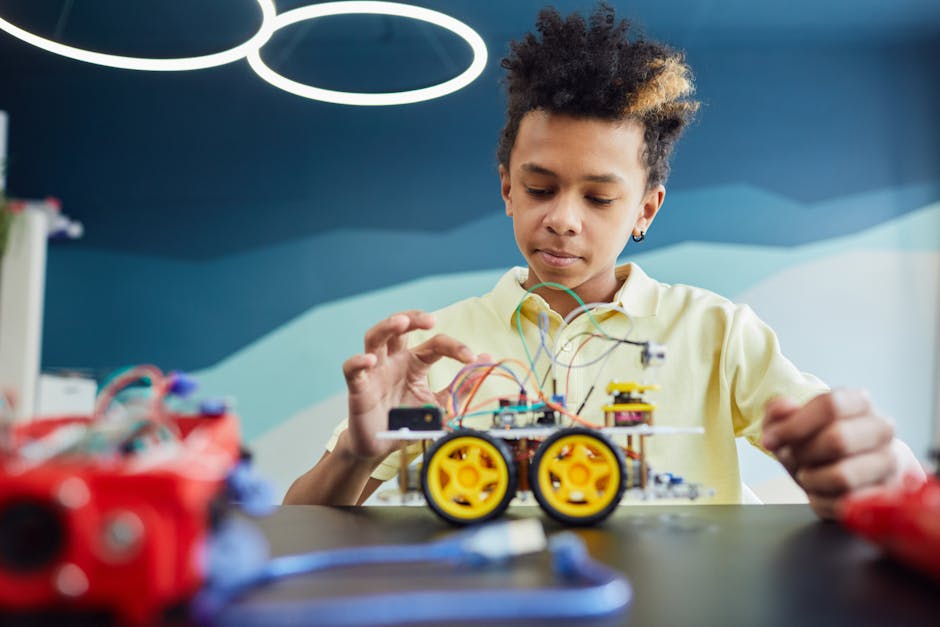AI Project Ideas for Computer Science Students
Artificial Intelligence is rapidly transforming various industries, creating exciting opportunities for computer science students. Diving into AI projects is not just about learning new technologies; it’s about developing critical thinking, problem-solving, and innovation skills. These projects can significantly enhance your resume, showcase your abilities to potential employers, and prepare you for a future driven by AI. This article explores various AI project ideas tailored for computer science students, offering a blend of theoretical knowledge and practical application.
Background of AI in Computer Science Projects

The field of Artificial Intelligence has evolved significantly since its inception. Early AI projects focused on rule-based systems and symbolic reasoning. Today, advancements in machine learning, deep learning, and natural language processing have opened up new avenues for creating intelligent systems. Modern AI projects involve complex algorithms, large datasets, and sophisticated computational techniques. Understanding this background is crucial for students embarking on AI-focused projects.
Evolution of AI Techniques
From expert systems to neural networks, AI has seen various paradigms shift. Understanding the strengths and limitations of each technique is vital for selecting the right approach for a specific problem. For instance, a simple classification task might be well-suited for a traditional machine learning algorithm, while a complex image recognition problem would benefit from deep learning.
The Rise of Machine Learning and Deep Learning
Machine learning and deep learning have become central to modern AI. Machine learning algorithms learn patterns from data without explicit programming, while deep learning uses artificial neural networks with multiple layers to analyze data at different levels of abstraction. This allows for the development of AI systems that can perform tasks such as image recognition, natural language understanding, and predictive modeling with high accuracy.
Ethical Considerations in AI
As AI systems become more powerful and pervasive, ethical considerations are increasingly important. Issues such as bias in algorithms, data privacy, and the potential impact on employment must be carefully considered when developing AI projects. Students should strive to create AI systems that are fair, transparent, and aligned with human values.
Importance of AI Projects for Students

Engaging in AI projects offers numerous benefits for computer science students. These projects provide hands-on experience, allowing students to apply theoretical knowledge to real-world problems. They also foster creativity, critical thinking, and problem-solving skills, which are highly valued by employers. Furthermore, AI projects can significantly enhance a student’s portfolio, showcasing their expertise and making them more competitive in the job market.
Practical Application of Theoretical Knowledge
AI projects bridge the gap between theory and practice. By working on projects, students gain a deeper understanding of AI concepts and learn how to apply them effectively. This practical experience is invaluable for building a strong foundation in AI.
Development of Critical Skills
AI projects require students to analyze complex problems, design solutions, and implement them using appropriate tools and techniques. This process helps develop critical thinking, problem-solving, and analytical skills, which are essential for success in the field of computer science.
Portfolio Enhancement
A well-executed AI project can be a valuable asset for a student’s portfolio. It demonstrates their ability to apply AI concepts to solve real-world problems, showcasing their skills to potential employers. A strong portfolio can significantly increase a student’s chances of landing a job in the AI industry.
Benefits of Working on AI Projects

Beyond enhancing a portfolio and solidifying skills, AI projects provide a deeper understanding of AI’s potential and limitations. They can lead to innovation, research opportunities, and even entrepreneurial ventures. The benefits extend beyond academic success, preparing students for a dynamic and rapidly evolving job market.
Deeper Understanding of AI Concepts
Working on AI projects forces you to grapple with the intricacies of algorithms, data structures, and software design. This hands-on experience translates to a far richer understanding than simply reading about the concepts in a textbook. You learn how different algorithms behave in practice, how to tune them for optimal performance, and when to choose one algorithm over another.
Increased Creativity and Innovation
AI is a rapidly evolving field, and there’s often no single “right” way to solve a problem. This encourages creativity and innovation. You might need to adapt existing algorithms, combine different techniques, or even develop entirely new approaches to achieve your goals. This process of experimentation and discovery is invaluable for fostering a creative mindset.
Preparation for a Dynamic Job Market
The demand for AI professionals is skyrocketing. By working on AI projects, you’re not just learning about the technology; you’re also gaining practical experience that employers are actively seeking. This can give you a significant edge in the job market, opening doors to a wide range of career opportunities.
AI Project Ideas: A Step-by-Step Guide

Embarking on an AI project can seem daunting, but breaking it down into manageable steps can make the process much easier. This section provides a step-by-step guide to help students plan, execute, and complete AI projects successfully.
Step 1: Defining the Project Scope and Objectives
The first step is to clearly define the scope and objectives of the project. What problem are you trying to solve? What specific goals do you want to achieve? A well-defined scope will help you stay focused and avoid scope creep.
* Example: “Develop an AI-powered chatbot to answer frequently asked questions on a university website.”
Step 2: Data Collection and Preparation
Most AI projects require data to train and evaluate the model. Collect relevant data from reliable sources and prepare it for training. This may involve cleaning the data, handling missing values, and transforming it into a suitable format.
* Actionable Step: Use libraries like Pandas in Python to clean and preprocess your data. Consider data augmentation techniques if your dataset is small.
Step 3: Model Selection and Training
Choose an appropriate AI model based on the project’s objectives and the nature of the data. Train the model using the prepared data and evaluate its performance using appropriate metrics.
* Actionable Step: Experiment with different algorithms (e.g., linear regression, decision trees, neural networks) and tune their hyperparameters to optimize performance.
Step 4: Implementation and Testing
Implement the trained model into a functional system. Test the system thoroughly to ensure it meets the project’s objectives and performs reliably.
* Actionable Step: Use testing frameworks to automate the testing process and ensure comprehensive coverage.
Step 5: Documentation and Presentation
Document the entire project, including the problem statement, methodology, results, and conclusions. Prepare a presentation to showcase your work and share your findings with others.
* Actionable Step: Use tools like LaTeX or Markdown to create a professional-looking report. Practice your presentation to ensure you can effectively communicate your work.
Examples of AI Projects for Computer Science Students

Here are some specific AI project ideas categorized by difficulty level, along with brief descriptions and potential technologies to use. These examples serve as inspiration for students looking to embark on their own AI projects.
Beginner-Level Projects
1. Simple Chatbot
Description: A basic chatbot that can answer simple questions based on a predefined knowledge base.
Technologies: Python, NLTK, Dialogflow.
Actionable Step: Start with a small knowledge base and gradually expand it as you learn more.
2. Sentiment Analysis of Text
Description: Analyze text data (e.g., social media posts, product reviews) to determine the sentiment expressed (positive, negative, or neutral).
Technologies: Python, scikit-learn, NLTK, TextBlob.
Actionable Step: Use pre-trained sentiment analysis models and fine-tune them with your own data.
3. Image Classification with Convolutional Neural Networks (CNNs)
Description: Classify images into different categories using CNNs.
Technologies: Python, TensorFlow, Keras, PyTorch.
Actionable Step: Start with a simple CNN architecture and gradually increase its complexity as you improve performance.
Intermediate-Level Projects
1. Object Detection in Images and Videos
Description: Detect and locate objects in images and videos using object detection algorithms.
Technologies: Python, TensorFlow, Keras, OpenCV, YOLO.
Actionable Step: Use pre-trained object detection models and fine-tune them with your own data to improve accuracy.
2. Natural Language Generation (NLG)
Description: Generate human-like text from structured data or other input sources.
Technologies: Python, TensorFlow, Keras, PyTorch, Transformers.
Actionable Step: Experiment with different NLG models and evaluate their performance using metrics such as BLEU and ROUGE.
3. Predictive Maintenance
Description: Predict when equipment or machinery is likely to fail based on sensor data and historical maintenance records.
Technologies: Python, scikit-learn, TensorFlow, Keras, Time Series Analysis.
Actionable Step: Gather relevant sensor data and use machine learning algorithms to identify patterns and predict failures.
Advanced-Level Projects
1. Generative Adversarial Networks (GANs)
Description: Generate new, realistic data samples using GANs.
Technologies: Python, TensorFlow, Keras, PyTorch.
Actionable Step: Experiment with different GAN architectures and training techniques to generate high-quality data samples.
2. Reinforcement Learning
Description: Train an agent to make decisions in an environment to maximize a reward signal.
Technologies: Python, TensorFlow, Keras, PyTorch, OpenAI Gym.
Actionable Step: Start with simple reinforcement learning environments and gradually increase the complexity as you learn more.
3. AI-Powered Medical Diagnosis
Description: Develop an AI system that can assist doctors in diagnosing diseases based on medical images, patient records, and other data sources.
Technologies: Python, TensorFlow, Keras, PyTorch, Medical Imaging Libraries.
Actionable Step: Work with medical professionals to gather relevant data and develop accurate and reliable diagnostic models.
Strategies for Success in AI Projects

To maximize your chances of success, consider these strategies when working on AI projects. These tips cover everything from effective collaboration to continuous learning and staying updated with the latest advancements in the field.
Collaboration and Teamwork
AI projects often involve complex tasks that are best tackled by a team. Collaborate with other students to share knowledge, divide tasks, and learn from each other. Effective communication and teamwork are essential for success.
Continuous Learning and Improvement
AI is a rapidly evolving field, so it’s important to stay updated with the latest advancements. Continuously learn new concepts, techniques, and tools to improve your skills and knowledge.
Experimentation and Iteration
AI projects often involve experimentation and iteration. Don’t be afraid to try new things, make mistakes, and learn from them. Iterate on your designs and implementations to improve performance and achieve your goals.
Challenges and Solutions in AI Projects
AI projects can present various challenges, such as data scarcity, computational limitations, and model overfitting. This section discusses these challenges and offers potential solutions to overcome them.
Data Scarcity and Augmentation
Challenge: Many AI projects require large amounts of data, which may not always be available.
Solution: Use data augmentation techniques to generate synthetic data and increase the size of your dataset.
Computational Limitations
Challenge: Training complex AI models can require significant computational resources, such as GPUs and large amounts of memory.
Solution: Use cloud-based computing platforms or distributed computing techniques to access the necessary resources.
Model Overfitting
Challenge: AI models can sometimes overfit the training data, resulting in poor performance on unseen data.
Solution: Use regularization techniques, such as L1 or L2 regularization, to prevent overfitting.
FAQ: AI Projects for Computer Science Students
Here are some frequently asked questions about AI projects for computer science students.
Q1: What are the best programming languages for AI projects?
A: Python is the most popular language due to its extensive libraries like TensorFlow, Keras, and PyTorch. R is also used for statistical analysis.
Q2: How much math is needed for AI projects?
A: A solid understanding of linear algebra, calculus, probability, and statistics is beneficial for understanding AI algorithms.
Q3: Where can I find datasets for my AI projects?
A: Websites like Kaggle, UCI Machine Learning Repository, and Google Dataset Search offer a wide range of datasets.
Q4: What are some free resources for learning AI?
A: Platforms like Coursera, edX, and Udacity offer free AI courses. YouTube channels and blogs are also great resources.
Q5: How can I showcase my AI projects to potential employers?
A: Create a portfolio website or GitHub repository to showcase your projects. Document your work clearly and highlight your contributions.
Conclusion
AI projects offer computer science students an invaluable opportunity to learn, grow, and prepare for a future driven by artificial intelligence. By carefully planning, executing, and documenting your projects, you can build a strong portfolio that showcases your skills and expertise. Embrace the challenges, stay curious, and continuously learn to unlock the full potential of AI. Start your AI project today and embark on a journey of innovation and discovery!
Ready to start your AI journey? Explore the project ideas mentioned above, gather your resources, and begin building the future today!

